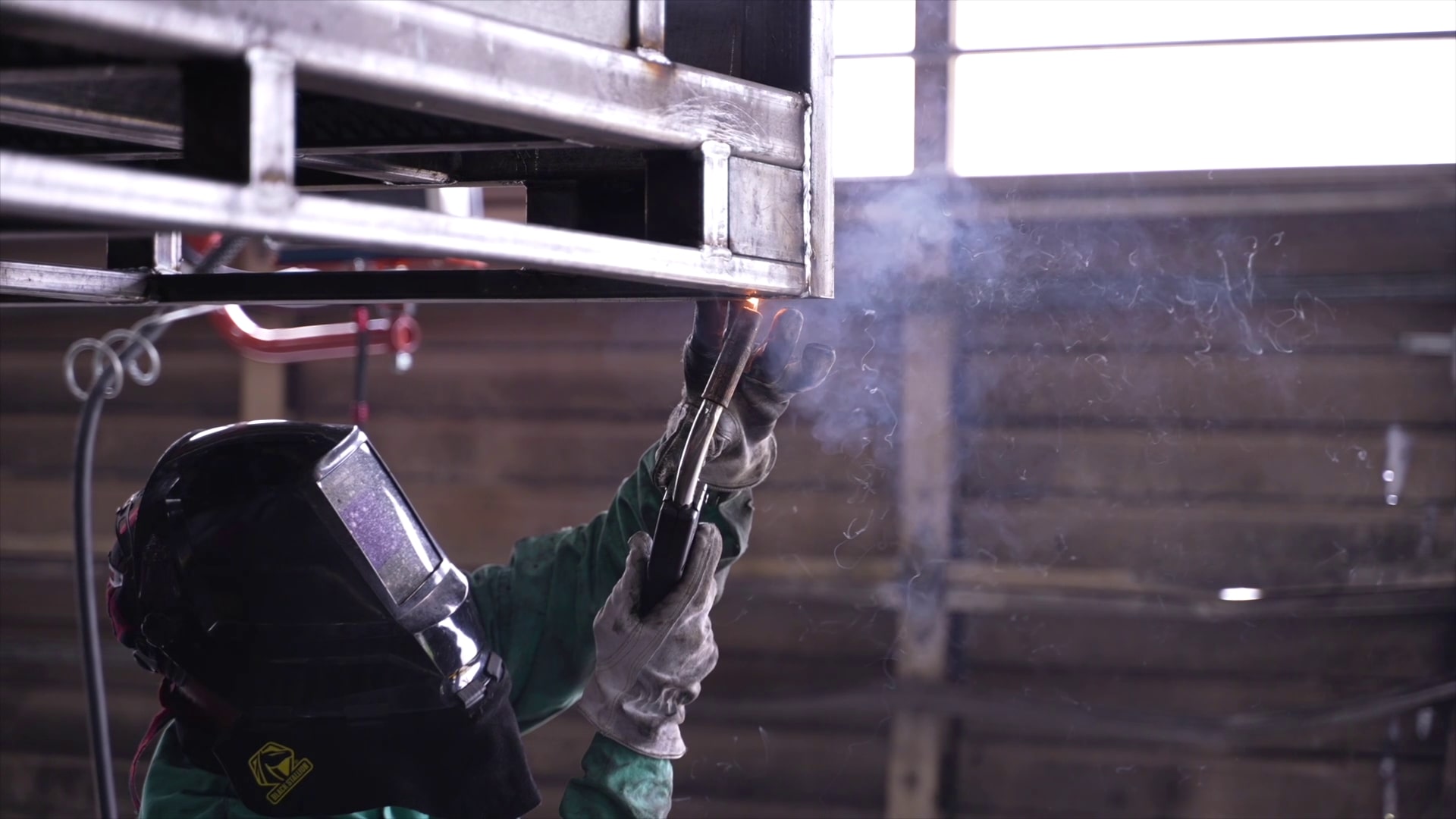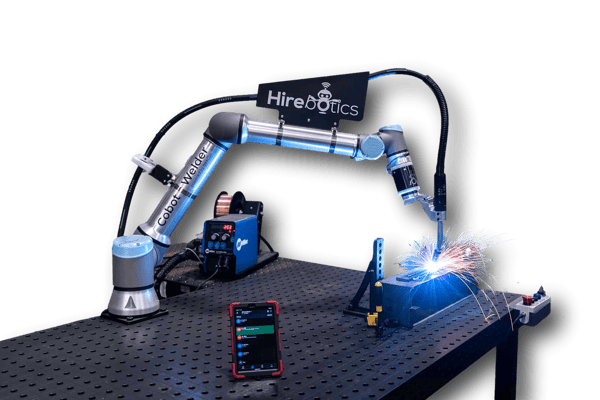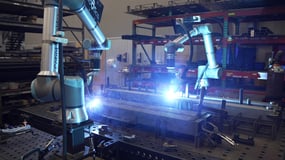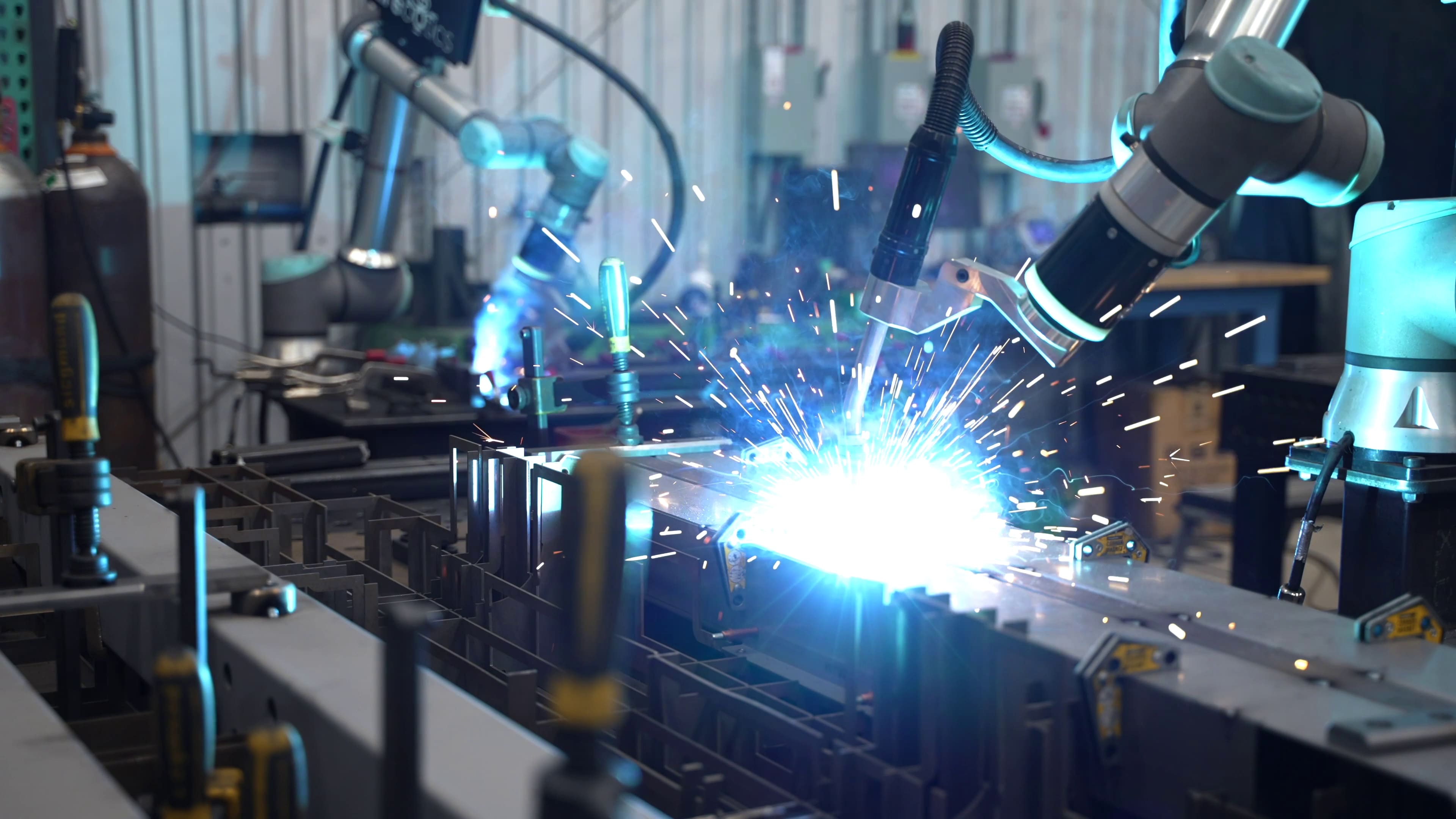Collaborative Welding Cobots Changing the Industry
The use of welding cobots for all types of manufacturing applications is helping small and medium shops compete with larger operations.
A welding cobot makes it possible to increase throughput and reduce quality issues. And, it’s much easier to get started with automating your welding operations than you may think.
The growing skills shortage for qualified welders continues to put the manufacturing sector in the U.S. under pressure.
For small and medium fabricators, this often cuts them out of jobs due to capacity constraints or the cost associated with hiring additional welders. Investing in a welding cobot enables you to establish consistent, repeatable welding while empowering your welders.

There is a growing need for small and medium manufacturers to automate their production processes wherever possible. To remain competitive, fabricators need to reduce costs, save materials, and increase productivity without compromising on quality.
Welding cobots are ideal for a shop that needs a solution with a suitable ROI and don’t require you to hire programmers to operate the platform.
What is a Collaborative Robot (Cobot)?
The name cobot refers to a collaborative robot. These platforms are affordable and can work with people or other cobots.
With a small footprint, you can place the cobot anywhere in your shop and use them for a variety of industrial applications.

The first mainstream industrial collaborative robot was created in 2016 by Universal Robots. It was first invented to make pizzas in a tight environment that could have humans around. The founders wondered how they could create a robot that would have a small footprint, be safe to move around humans, and be easy and accessible to program.
Since then, multiple design iterations have continued to refine the technology, and today, we have many types and brands of collaborative robots transforming the robotics industry.
Universal Robots, to this day, still is the most used collaborative robot in the world with the majority of the market share.
Here are the latest URs from Universal Robots: UR3e, UR5e, UR10e, Ur16e.

With an UR10e cobot platform, you can:
- Lift a payload of up to 25 kilograms / 27.55 pounds
- Reach across an area of 1,300 millimeters / 55.1 inches
- Carry out repetitive tasks like material handling and welding with easy programming
- Fit the cobot into a footprint of only 190 square millimeters / 7.4 square inches
Due to the versatility of the UR10e platform, using cobots for precise, repetitive fabrication tasks has become popular in manufacturing shops around the world.
Read more about Universal Robots Welding here.
What is a Welding Cobot?
A welding cobot is a collaborative robot for welding with all the fixtures and effectors required to perform high-quality welds on a variety of workpieces.

They’ve become popular with all sizes of operations as it provides for higher throughput, increased repeatability, and without compromising on quality.
Although robotic MIG welding using industrial robots is common across the manufacturing industry, these platforms are bulky, expensive to install, and require extensive programming to use effectively.
A welding cobot is a compact solution that is ideal when there are weld operations required on different types of workpieces. Fabricators can automate their welding processes for low volume, high mix applications using a welding cobot.
The cobot welder incorporates all of the advantages of a cobot into the welding operation, including sensing and precise execution of each programmed action.
It enables SMEs to solve the challenge of hiring more welders by letting their current workforce program (or teach) the cobot how to perform the required weld.
Some of the key benefits available from welding cobots are:
- Increased throughput for repetitive welding jobs that increases profitability
- Consistent quality welds that’s not always possible if welders become fatigued
- Efficient use of materials and consumables for each weld operation
- Frees up your welders to focus on value-added tasks while the cobot handles mundane repetitive jobs
Industries Using Welding Cobots
Welding cobots are becoming common in all types of fabrication industries. Wherever you need to produce welded parts, a cobot welder can help increase productivity and maximize the efficiency for each shift.
When speed and precision are key to the success of a workpiece, a welding cobot is the best option available to SMEs. Because the system is flexible enough to adapt to any type of welding operation and professional welders can teach the robot the exact execution for each weld, it can increase production capacity while maintaining joint integrity.
Collaborative welding robots are now used in industries like:
- Automotive – Car parts that need to work under pressure benefit from both spot and arc welding cobots
- Aerospace – Airplanes and UAVs require high-precision quality joints on lightweight materials to perform consistently
- Appliances – Any kind of appliance manufacturer that needs to weld two metal parts along a seam with a flawless finish
- Heavy equipment – When dealing with stronger steel grades, a welding cobot can handle multi-segment and radial welds expertly
In almost every application where you need a high-quality weld executed repeatedly and consistently, a cobot welding platform can assist.
Primary Components of a Cobot Welding System
Apart from the robot hardware and weld system, a cobot welder also has additional components in order to function properly.
When looking at automating the welding workflow, you’ll need to consider:

- The cobot itself (such as the UR10e from Universal Robots)
- The welding system, which includes the power supply, control interface, cables, housing, and cooling systems
- The welding gun (or weld effector) that sits at the end of the cobot arm
- Ancillary tooling and sensors for improved process control and operational safety (More about weld seam tracking systems here)
- Dedicated safety equipment including electrical interlocking guards and light curtains
- Programming interface and operator control software for interacting with the welding cobot
Depending on the type of welding application, you may require additional components to automate the process.
The best way to know what exactly you’ll need is to get in touch with an expert integrator that can guide you through the system architecture, tooling options, and ancillary devices you may require as well as robotic welding safety.
If you want more information about what exactly goes into a cobot welding platform, check out our eBook.
How Do You Program a Welding Cobot?
Discover How to Program the Cobot Welder Here
Industrial robots require programmers to set up the operational parameters of the system.
However, various new welding cobot tools are now available on the market.
The “ease-of-use” programming interface of those collaborative robots has made welding with robots more accessible to companies without expertise in automation. Operators can now grab the robot by hand, move it to the points to record, and use the teach pendant interface to set parameters.
![]()
The welding cobot from Universal Robots and Hirebotics has even pushed the “ease-of-programming” a notch further.
Hirebotics makes it easier to program the robot by not using the standard UR training pendant or the URCap.
Your welders can use our Beacon app to program each movement without needing to understand cobot programming.
A smart puck lets the operator guide the robot arm to the different positions and programs the exact coordinates at the push of a button.

The welder only has to worry about welding parameters such as speed, feed, and weaving values.
Once the program is in place, you can initiate the system and see it follow the precise movements by clicking a button on the operator panel.
By carrying out these steps, you can create a library of weld programs and simply call up the one you need for a specific workpiece in the future.
Curious about how the Cobot Welder is programmed through an App? Book your Demo today!
Cobot Welding Applications
Welding cobots can handle any kind of application just like a qualified welder. Different platforms support Arc welding, MIG, TIG, laser, plasma, ultrasonic, and spot welding. You can also set it up for soldering or brazing if required.
The Hirebotics cobot welder system uses a Miller Invision 352 MPa Pulsed Welder with an S74 feeder. This gives you maximum flexibility for both steel and aluminum applications.
The weld system also has parameters pre-programmed for MIG and Pulsed MIG welding for a variety of wires, making it easy to set up for optimal performance.
Combined with a Tregaskiss Tough Gun and the Siegmund 48” x 32” welding cart, the system remains compact enough to fit into any workshop or factory.

Using this platform, fabricators can:
- Develop specific weld programs for individual workpieces or parts and store them for future reference
- Quickly switch between different weld programs and workpieces as required
- Establish a consistent, repeatable, and semi-autonomous weld workflow for increased productivity
- Increase the throughput of each shift and take on more orders without hiring additional welders
As the system will execute each program consistently, you can also improve your pricing and quoting process.
You’ll know the exact time each weld will take, how much consumables you’ll use, and how many workpieces you can handle over a specific period.
Which Welding Types Can You Automate with a Welding Cobot?
Just like with the applications listed above, you can program almost any type of weld using a welding cobot. For some applications, you may need to include additional sensing devices and jigs to manipulate the workpiece for the weld gun to reach each spot according to your needs.
For larger workpieces, you can combine more than one cobot to lift the piece and move it into the desired position.
If you need to automate more steps of the fabrication process, you’re able to include different systems and controls across the welding workflow for increased efficiency and throughput.

The most common type of weld that you can automate with the Hirebotics platform is MIG (GMAW). These welds are common in thicker metal applications such as aluminum, stainless steel, and carbon steel.
How to Choose a Welding Cobot for Your Shop
Once you’ve decided to invest in a welding cobot, you’ll need to ensure you get the best platform for your process. The selection of a cobot welding package needs to cover all of your requirements and enable your welders to operate the system instead of resorting to hiring programmers.

Below, we look at some of the main considerations to include when choosing a welding cobot.
1. Ease of Use
How easy the system is to use is one of the most important considerations when choosing your welding cobot. While many manufacturers will claim that it’s easy to set up and program the system, it’s often much more complex than the sales agent will admit.
If you need to resort to hiring programmers along with your new cobot then the ROI won’t make sense when working with low volume, high mix workpieces.
The Hirebotics welding cobot allows your professional welders to program welds without resorting to writing any code. You won’t need to teach communication protocols like TCP/IP to your welders. Instead, you can allow them to teach the cobot how to weld.
Using the Beacon app mentioned above, the welder will walk the cobot through the movements and program the coordinates with the touch of a button.
![]()
Once the program is available on the cobot, you can start the system, and it will automatically execute the weld as per the captured parameters and settings defined by the welder.
2. Time from Unboxing to Production
The time it takes to set up the cobot with all its components from when you receive the box until you can start welding is another major consideration.
If the setup process is complex or you need to have external parties assist with the process, then it will take longer before you can start recuperating your investment. It may also mean you need to call an application engineer if anything goes wrong and you need to troubleshoot the cobot welding package.

The less time it takes your welders to learn how to operate and reprogram the system, the greater your revenues and the more flexible your welding operations become.
Remember that you want the welding cobot to support your welding workflow and not change your entire business process to accommodate it.
3. After Sales Services and Support
The components that make up the welding cobot package will come from a variety of OEMs and suppliers. To maximize the ROI, you’ll need the system to provide you with maximum uptime, and that will come down to the aftersales services and support.
Does your supplier provide you with a single point of contact for any questions or troubleshooting advice you may need?
You’ll also need to look at the cobot manufacturer’s market penetration.
Universal Robots is the world’s leading cobot manufacturer with almost 50% of all cobots in operations being UR models. The greater the market share, the easier it will be to get dedicated support and expert advice on how to operate and maintain the cobot.
The same applies to the welding system and any ancillary components used in the platform.
Hirebotics’ Cobot Welder comes with its cloud-based Beacon software which provides them full control over the interface. They are then able to roll out new features and requests easily and fast to their users.
Combine these quick feature implementations to their in-app support chat and videos, and you have very responsive company support - 2 minutes average response time!
This makes them stand out as they are able to provide feedback in minutes and not days or weeks!
4. Reporting and Analytics
Finally, the quality of your welds as well as the accuracy of your quotes depends on capturing key data about your welding process.
The software behind the system needs to generate reports that you can use to refine your welding projects and improve the accuracy of your per-unit cost. Information about cycle times and material usage will enable you to find the ideal price point and accurately forecast your current production capacity.
![]()
With Hirebotics, using the Beacon app, you can also set up alerts to let operators know once the cobot completes a job and needs the operator’s attention, helping limit downtimes.
With improved reporting and analytics, you can maximize your entire operation for improved profitability.
Final Thoughts on Welding Cobots
The manufacturing and fabrication industry faces many challenges due to skills shortages and changes in production techniques. Larger firms that have the capital available are pricing SMEs out of the industry by embracing automation at every stage of the process.

With the rise of cobots and semi-autonomous fabrication techniques, SMEs can fight back and provide a competitive alternative to customers.
Welding cobots enable you to free up your resources to focus on high-value tasks by taking care of the repetitive, mundane operations in your shop.
The cobots from Universal Robots are robust and can work for as long you need them without suffering from fatigue that could lead to quality issues and rework.
As welding cobots are now a cost-effective alternative, you don’t have to turn away orders due to the shortage of professional welders available on the market.
Using the Hirebotics welding cobot package, you’re able to empower your current workforce to be more productive and won’t have to compromise on quality.
The Beacon app works on any smartphone or tablet and has a familiar interface that most workers can grasp easily.
Welders can focus on welding parameters instead of having to learn how to program a cobot, speeding up the time it takes to recuperate your ROI.
With a welding cobot, you benefit from:
- A streamlined welding process executed precisely according to your operated defined weld operations
- Increased throughput during every shift while eliminating quality issues for reduced rework
- A cost-effective automation solution that drives up revenues and is easy to use without the need to learn to program
- A robust support network with welding experts available to guide you through the setup, maintenance, and troubleshooting processes





